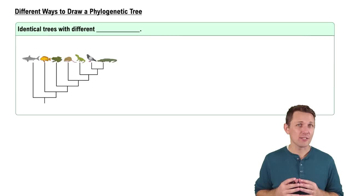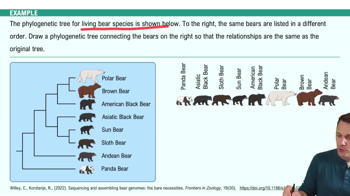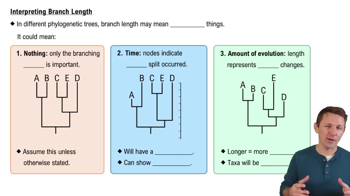Table of contents
- 1. Introduction to Biology2h 40m
- 2. Chemistry3h 40m
- 3. Water1h 26m
- 4. Biomolecules2h 23m
- 5. Cell Components2h 26m
- 6. The Membrane2h 31m
- 7. Energy and Metabolism2h 0m
- 8. Respiration2h 40m
- 9. Photosynthesis2h 49m
- 10. Cell Signaling59m
- 11. Cell Division2h 47m
- 12. Meiosis2h 0m
- 13. Mendelian Genetics4h 44m
- Introduction to Mendel's Experiments7m
- Genotype vs. Phenotype17m
- Punnett Squares13m
- Mendel's Experiments26m
- Mendel's Laws18m
- Monohybrid Crosses19m
- Test Crosses14m
- Dihybrid Crosses20m
- Punnett Square Probability26m
- Incomplete Dominance vs. Codominance20m
- Epistasis7m
- Non-Mendelian Genetics12m
- Pedigrees6m
- Autosomal Inheritance21m
- Sex-Linked Inheritance43m
- X-Inactivation9m
- 14. DNA Synthesis2h 27m
- 15. Gene Expression3h 20m
- 16. Regulation of Expression3h 31m
- Introduction to Regulation of Gene Expression13m
- Prokaryotic Gene Regulation via Operons27m
- The Lac Operon21m
- Glucose's Impact on Lac Operon25m
- The Trp Operon20m
- Review of the Lac Operon & Trp Operon11m
- Introduction to Eukaryotic Gene Regulation9m
- Eukaryotic Chromatin Modifications16m
- Eukaryotic Transcriptional Control22m
- Eukaryotic Post-Transcriptional Regulation28m
- Eukaryotic Post-Translational Regulation13m
- 17. Viruses37m
- 18. Biotechnology2h 58m
- 19. Genomics17m
- 20. Development1h 5m
- 21. Evolution3h 1m
- 22. Evolution of Populations3h 52m
- 23. Speciation1h 37m
- 24. History of Life on Earth2h 6m
- 25. Phylogeny2h 31m
- 26. Prokaryotes4h 59m
- 27. Protists1h 12m
- 28. Plants1h 22m
- 29. Fungi36m
- 30. Overview of Animals34m
- 31. Invertebrates1h 2m
- 32. Vertebrates50m
- 33. Plant Anatomy1h 3m
- 34. Vascular Plant Transport2m
- 35. Soil37m
- 36. Plant Reproduction47m
- 37. Plant Sensation and Response1h 9m
- 38. Animal Form and Function1h 19m
- 39. Digestive System10m
- 40. Circulatory System1h 57m
- 41. Immune System1h 12m
- 42. Osmoregulation and Excretion50m
- 43. Endocrine System4m
- 44. Animal Reproduction2m
- 45. Nervous System55m
- 46. Sensory Systems46m
- 47. Muscle Systems23m
- 48. Ecology3h 11m
- Introduction to Ecology20m
- Biogeography14m
- Earth's Climate Patterns50m
- Introduction to Terrestrial Biomes10m
- Terrestrial Biomes: Near Equator13m
- Terrestrial Biomes: Temperate Regions10m
- Terrestrial Biomes: Northern Regions15m
- Introduction to Aquatic Biomes27m
- Freshwater Aquatic Biomes14m
- Marine Aquatic Biomes13m
- 49. Animal Behavior28m
- 50. Population Ecology3h 41m
- Introduction to Population Ecology28m
- Population Sampling Methods23m
- Life History12m
- Population Demography17m
- Factors Limiting Population Growth14m
- Introduction to Population Growth Models22m
- Linear Population Growth6m
- Exponential Population Growth29m
- Logistic Population Growth32m
- r/K Selection10m
- The Human Population22m
- 51. Community Ecology2h 46m
- Introduction to Community Ecology2m
- Introduction to Community Interactions9m
- Community Interactions: Competition (-/-)38m
- Community Interactions: Exploitation (+/-)23m
- Community Interactions: Mutualism (+/+) & Commensalism (+/0)9m
- Community Structure35m
- Community Dynamics26m
- Geographic Impact on Communities21m
- 52. Ecosystems2h 36m
- 53. Conservation Biology24m
25. Phylogeny
Phylogeny
Problem 2d
Textbook Question
Critique the following statement: The absence of a trait cannot be used as a synapomorphy in phylogenetic analysis; only shared derived traits that are present in the clade can be used.
 Verified step by step guidance
Verified step by step guidance1
Understand the terms: A synapomorphy is a characteristic shared by two or more taxa that is inherited from their most recent common ancestor. Phylogenetic analysis involves the study of the evolutionary relationships among groups of organisms.
Analyze the statement: The statement claims that only traits that are present and derived (newly evolved traits that distinguish a clade) can be used as synapomorphies in phylogenetic analysis, implying that absent traits cannot serve this purpose.
Consider exceptions: Think about cases where the absence of a trait could be a derived condition if the ancestor had the trait and the derived taxa lost it. This absence could potentially be considered a synapomorphy if it provides information about evolutionary relationships.
Evaluate the relevance of absent traits: Determine if the absence of a trait can be reliably identified as a derived condition rather than a primitive condition (a trait that was absent in the ancestor). This is crucial for its use in phylogenetic analysis.
Conclude the critique: While the statement holds in scenarios where the absence of a trait cannot be clearly identified as a derived condition, there are cases where an absent trait can be a synapomorphy if it represents a derived state that helps clarify evolutionary relationships among taxa.
 Verified video answer for a similar problem:
Verified video answer for a similar problem:This video solution was recommended by our tutors as helpful for the problem above
Video duration:
1mPlay a video:
Was this helpful?
Key Concepts
Here are the essential concepts you must grasp in order to answer the question correctly.
Synapomorphy
A synapomorphy is a shared derived trait that is used to infer evolutionary relationships among organisms. It is a characteristic that is present in an ancestor and its descendants but absent in more distant relatives. In phylogenetic analysis, synapomorphies help define clades, which are groups of organisms that share a common ancestor.
Recommended video:
Guided course

Cladistics
Phylogenetic Analysis
Phylogenetic analysis is a method used to study the evolutionary relationships between different species or groups. It involves constructing a phylogenetic tree, which visually represents these relationships based on shared traits, genetic data, or other characteristics. The accuracy of this analysis relies heavily on identifying synapomorphies and understanding the evolutionary history of the organisms involved.
Recommended video:

Building Phylogenetic Trees Example 2
Clade
A clade is a group of organisms that includes an ancestor and all its descendants, forming a branch on the tree of life. Clades are defined by synapomorphies, which are traits that are unique to that group. Understanding clades is essential for interpreting phylogenetic trees and recognizing how different species are related through common ancestry.
Recommended video:
Guided course

Cladistics

 7:10m
7:10mWatch next
Master Reading a Phylogenetic Tree with a bite sized video explanation from Bruce Bryan
Start learningRelated Videos
Related Practice




















